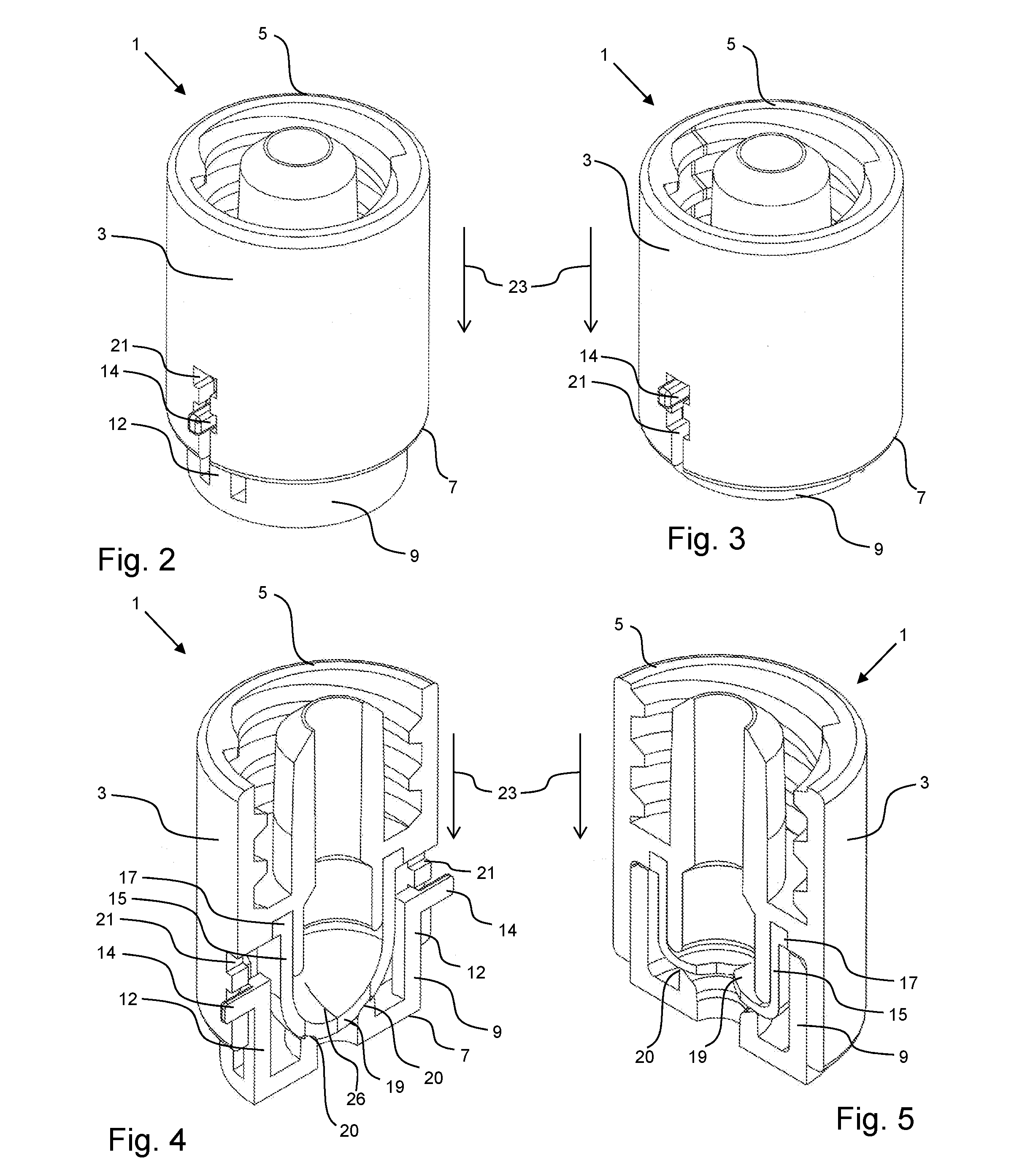Needlefree valve device
a valve device and needle-free technology, applied in the field of needle-free medical valve devices, can solve the problems of high manufacturing cost and achieve the effect of expanding flexibility
- Summary
- Abstract
- Description
- Claims
- Application Information
AI Technical Summary
Benefits of technology
Problems solved by technology
Method used
Image
Examples
first embodiment
[0046]The latches 12 with their grip protrusions 14 are adapted to be inserted into the recesses 21 on first component 3 when the valve device 1 according the invention is operable. In the following, the function of this first embodiment of the valve device will be explained in more detail with respect to FIGS. 2 to 5.
[0047]FIG. 2 shows a perspective view of the first embodiment of valve device 1 in the closed configuration. Second component 9 is connected to first component 3 with the sealing component 15 arranged in between (not shown). In the closed configuration depicted in FIG. 2 the latches 12 with the grip protrusion 14 are engaged with the lower portion of recess 21 in the outer surface of first component 3. It must be noted that the structure of the embodiment depicted in FIG. 2 comprises a short portion of second component 9 extending from the valve end 7 of first component 3. This portion may have other dimensions depending on the type of connection at connector end 11 of...
second embodiment
[0052]Recess 21 of first component 3 comprises a substantially rectangular configuration with a larger extension in the circumferential direction than in the axial direction parallel to the opening axis 23. Approximately in the middle of the longitudinal extension of recess 21 there is a locking arm 22 extending in a circumferential direction into recess 21 giving recess 21 a U-shape wherein the “U” is rotated by 90° with respect to the valve axis 4. In the embodiment shown as the second embodiment in FIGS. 6 to 10 the locking arm 22 extends from the right side wall in the outer surface of first component 3. The reason for this arrangement of locking arm 22 within recess 21 will become clear with respect to the detailed description of FIGS. 7 to 10 below.
[0053]The difference between the first and the second embodiment with respect to the latch 12 is that in the second embodiment of FIG. 6 the free end of latch 12 near the valve end 13 does not comprise a grip protrusion 16 as in the...
third embodiment
[0064]The other possibility of movement for latch 12 out of the closed configuration depicted in FIG. 12 is the general opening movement of the valve in the opening direction indicated by arrow 23 which means that the engagement of the latch 12 with the locking arm 22 is released and the first component 3 is moved towards second component 9 until finally the position depicted in FIG. 14 is reached. In this open configuration, the protrusion 16 of latch 12 is in engagement with the upper portion of locking arm 22 and generally latch 12 is located in the right half of recess 21. From this open position in FIG. 14, a rotational movement in the circumferential direction of the first component 3 with respect to the second component 9 leads to the configuration depicted in FIG. 15, i. e. the engagement of latch 12 with locking arm 22 is released and latch 12 is now in the upper left corner of recess 21 when looking at FIG. 15. This configuration is an unstable configuration in the sense t...
PUM
 Login to View More
Login to View More Abstract
Description
Claims
Application Information
 Login to View More
Login to View More - R&D
- Intellectual Property
- Life Sciences
- Materials
- Tech Scout
- Unparalleled Data Quality
- Higher Quality Content
- 60% Fewer Hallucinations
Browse by: Latest US Patents, China's latest patents, Technical Efficacy Thesaurus, Application Domain, Technology Topic, Popular Technical Reports.
© 2025 PatSnap. All rights reserved.Legal|Privacy policy|Modern Slavery Act Transparency Statement|Sitemap|About US| Contact US: help@patsnap.com



